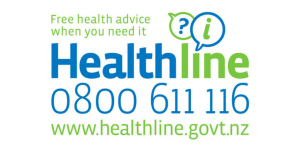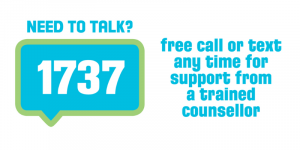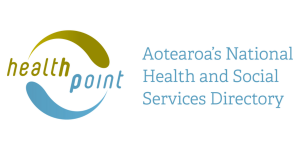Wishing everyone a safe and happy Christmas and New Year – Meri Kirihimete from the Healthify team.
Shingrix® vaccine
Also known as shingles vaccine
Key points about Shingrix
- The Shingrix vaccine protects against shingles infection.
- You need 2 doses, with the second dose given 2 to 6 months after the first.
- Find out about Shingrix and possible side effects.

Shingrix is a vaccine that can prevent you from getting shingles and, if you do get shingles, this vaccine can prevent you from complications of shingles including long-term pain.
- Anyone who has had chickenpox is at risk of developing shingles later in life – 1 in 3 people will get shingles during their lifetime.
- Shingles can be very painful and your risk of getting it increases as you get older.
- The most serious complications are nerve pain that can last for months or years, and eye problems that can result in loss of vision.
- Read more about shingles.
In Aotearoa New Zealand the shingles vaccination is free for some people:
- For people 65 years of age. As long as you receive your first dose when you're 65, your second dose will also be free. Ideally, your second dose is 2 to 6 months after your first dose but if it's longer than 6 months, it will still be free.
- For certain people 18 years of age and over who are at increased risk of shingles because of a health condition or treatment. Read more about the eligibility criteria for immunocompromised people(external link).
Shingrix vaccine is recommended for anyone from 50 years of age onwards, but it's only funded when you are 65.
Shingrix is given as an intramuscular injection (injected into the muscle) into your upper arm.
It's given as 2 doses. Ideally, the second dose is given 2 to 6 months after the first.
If you're immunocompromised (have a weakened immune system), the time between doses can be reduced to 1 to 3 months.
You may get more of a reaction after your vaccination if you’re getting the Shingrix vaccine at the same time as the influenza vaccine (Fluad Quad®) or the Arexvy® vaccine.
If this is a concern, talk to your healthcare provider about whether they recommend having a space of 1 week between these vaccines.
Shingrix shouldn't be given to anyone who:
- has had a severe allergy (anaphylaxis) to a previous dose of this vaccine, or a component of the vaccine
- currently has shingles.
If you have a minor illness, such as a cold, you can be vaccinated, but if you have a fever (temperature over 38°C) you should wait. Your healthcare provider can advise you on when to have it.
If you have a bleeding disorder, such as haemophilia or thrombocytopenia, intramuscular injections must be given cautiously. Check with your healthcare provider if you're in this group.
Funded and unfunded shingles vaccines can be given by your healthcare provider and some pharmacies. Find a provider near you by going to the Healthpoint website(external link) and entering your address.
- If you're eligible for a free vaccination, there won't be a cost for the shingles vaccine, but there may be an administration fee.
- If you're not eligible to get a free vaccination you'll need to pay.
- Pharmacists can administer Shingrix to people 50 years of age and over if they're trained as a vaccinator.
Note: You need 2 doses of the Shingrix vaccine. The second dose should ideally be given 2 to 6 months after the first. You may wish to book your appointment for the second dose after receiving the first, and put a reminder in your calendar.
Zostavax is the old brand of shingles vaccine and it was a single dose. Zostavax is no longer available.
If you've had Zostavax, or have had shingles recently, your immunity to shingles has been boosted. This reduces the chances of you getting it in the near future, so it's recommended that you wait at least a year before getting the Shingrix vaccine. You’ll need 2 doses of Shingrix and if you’re not 65 years of age, you’ll have to pay for these.
Some people with weakened immune systems, and who are at risk of getting shingles, can get the Shingrix vaccine sooner – from 3 months after a Zostavax vaccination or after having had shingles.
Shingrix® isn't a live vaccine, so it can't cause shingles.
- To provide good protection against shingles, you need 2 doses of Shingrix, with the second dose given 2 to 6 months after the first.
- Having a single dose doesn't protect you adequately.
Note: There's evidence that the incidence of shingles (herpes zoster) is increasing in Aotearoa New Zealand and also that COVID-19 infection increases the risk.
Like all medicines, vaccines can cause side effects, although not everyone gets them. If you're concerned about any symptoms you think might be related to your medicine, talk to your healthcare provider. The following information offers some guidance but doesn't include all possible side effects.
Common side effects
Tell your healthcare provider if these side effects bother you. They usually settle within a few days.
- Pain and redness at the injection site: Place a cold, wet cloth or ice pack where the injection was given. Leave it on for a short time. Don't rub the injection site. Read more about what happens after your immunisation(external link).
- Headache, feeling tired or weak, muscle aches, fever, shivering: Rest and drink plenty of liquids. The routine use of paracetamol isn’t recommended after vaccinations, but it may be used for severe discomfort.
- Nausea (feeling sick) or vomiting (being sick).
- Diarrhoea (runny poo/hamuti).
Phone 111 for an ambulance or go to your nearest accident and emergency (A&E) clinic if these occur
- Signs of an allergic reaction such as itchy skin, and rash, swollen lips or tongue, problems breathing, like a tight chest or shortness of breath. If you develops these signs within a few hours or days of the vaccination, call an ambulance or immediately go to the nearest hospital and tell them you have had a Shingrix vaccination.
Read more about medicines and side effects and reporting a reaction you think might be a side effect.
The following links have more information about Shingrix:
Shingrix(external link) The Immunisation Advisory Centre, NZ
Herpes zoster (shingles)(external link) The Immunisation Advisory Centre, NZ
Shingrix(external link) Consumer Information Medsafe, NZ
Brochures
Immunisation for older people(external link) HealthEd, NZ, 2022 Chinese (simplified)(external link), Chinese(external link), Cook Islands Māori(external link), English(external link), Hindi(external link), te reo Māori(external link), Samoan(external link), Tongan(external link)
Immunisation for older people (LARGE PRINT)(external link) Ministry of Health, NZ, 2022
References
- Shingrix(external link) The Immunisation Advisory Centre, NZ
- Zoster (herpes zoster/shingles) recombinant vaccine(external link) New Zealand Formulary, NZ
- Recombinant zoster (shingles) vaccine – what you need to know(external link) CDC, US
- Bhavsar A, Lonnet G, Wang C, et al. Increased risk of Herpes Zoster in adults ≥50 years old diagnosed with COVID-19 in the United States(external link) Open Forum Infect Dis. 2022;9(5):118
Brochures
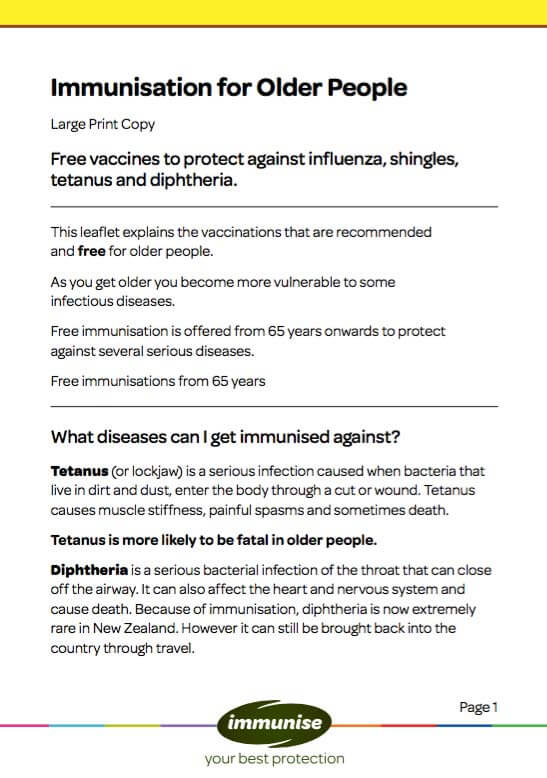
Ministry of Health, NZ, 2022
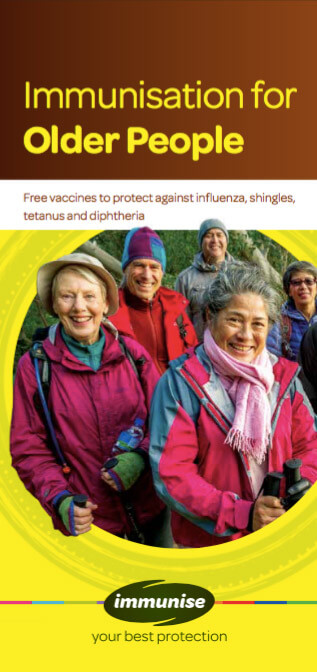
HealthEd, NZ, 2022
Chinese (simplified), Chinese, Cook Islands Māori, English, Hindi, te reo Māori, Samoan, Tongan
Medicines and side effects
Healthify He Puna Waiora, NZ, 2024
Credits: Healthify editorial team. Healthify is brought to you by Health Navigator Charitable Trust.
Reviewed by: Stephanie Yee, Pharmacist, Auckland.
Last reviewed:


